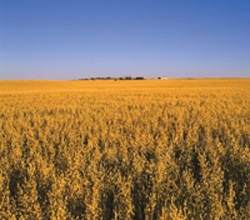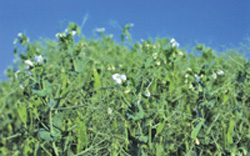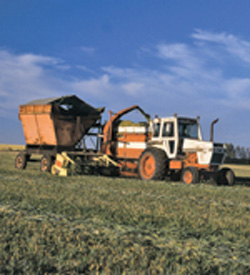
Features
Agronomy
Soybeans
Preventing herbicide resistance with fewer pesticides
That is not as hard as it sounds!
November 29, 2007 By Bruce Barker
Herbicide resistant weeds are now well established on many farms and they arrived
in one of several ways, including selection through repeated use of one herbicide
group, arrival in contaminated seed lots or farm machinery, or delivered to
your farm by birds, wind or water.
 |
| Skipping herbicides in oats can be done successfully. Photos Courtesy Of Bruce Barker. |
"Of these, herbicide selection of resistant weeds is by far the most important,"
explains Martin Entz, professor with the Department of Plant Science at the
University of Manitoba. "Therefore, strategies to prevent herbicide resistance
must involve reducing selection pressure on weeds."
A recent weed resistance survey conducted in Manitoba in 2004 highlights the
problem of herbicide resistant weeds. Forty percent of wild oats in farm fields
were found to be resistant to Group 1 herbicides, and 13 percent were resistant
to Group 2 herbicides. Plus, over one-half of wild oats resistant to Group 2
were also resistant to Group 1.
"Clearly, conventional farming systems have failed to prevent herbicide
resistant weeds from entering the farm," explains Entz. "The problem
of herbicide resistance in conventional farming systems will undoubtedly be
aggravated as more field crops are made resistant to only a few herbicide groups.
One thing is clear, farmers who do not change their farming systems will have
to deal with more herbicide resistant weeds in the future."
Entz says that despite the best practice of herbicide rotations, herbicide
resistance continues to grow. He says that possibly the best way to avoid herbicide
resistant weeds is to reduce herbicide use. Entz says that reducing herbicide
use is not as difficult as it sounds, and that it can actually bring benefits
outside of weed control, including better risk management and improved returns.
Increase crop diversity
In low crop diversity situations, the opportunity to reduce herbicide use is
correspondingly low. These simple crop rotations tend to be dominated by a few
weeds, such as wild oats and Canada thistle. Skipping herbicides might be possible
in certain years, however, this can result in weed outbreaks that increase the
seedbank and even increase the potential for herbicide resistance. Options in
these simple rotations include timing pre-emergence glyphosate applications
to maximize crop advantage over weeds, fertilizer placement and application
timing to favour crop growth, reduced nitrogen fertilizer rates and choosing
competitive crops such as oats and fall rye.
"Seeding date is a very powerful weed management tool, especially for
wild oats," says Entz. "Adding winter wheat or fall rye to a rotation
is the best way to change seeding date to influence weed communities."
 |
| Diverse rotations help increase flexibility and reduce dependence on herbicides. |
While those principles can bring some limited benefit in low crop diversity
systems, they really shine when crop diversity is increased. Entz says that
Pesticide Free Production (PFP) research and on-farm trials in Manitoba and
eastern Saskatchewan clearly show that herbicides can be eliminated in certain
years without threatening the crop yield or the bottom line.
Five years of trials from 2000 to 2005 at Carman and Brandon, Manitoba showed
that oats yields were never affected by skipping in-crop herbicide use when
a diverse crop rotation was used. The rotation at Carman was wheat-linola-oats-canola,
while the rotation at Brandon was wheat-canola-oats-pea. Both systems were under
no-till management. Crops following PFP oats did have significantly higher weed
populations, which may increase selection pressure for resistant weeds. However,
yields of crops following PFP crops (canola at Carman and peas at Brandon) were
never negatively affected by having a preceding PFP oats crop. In fact, in 2003
at Carman, yield of canola following PFP oats was actually significantly higher
than canola after sprayed oats.
Skipping in-crop herbicide use in linola was less successful than skipping
herbicides in oats, since linola is not very competitive with weeds. Eliminating
in-crop herbicide use in linola dramatically increased future weed problems.
Although unsprayed linola yielded 30 to 50 percent less than when weeds were
controlled with herbicides, yields of crops following PFP linola were not affected
by having a preceding PFP linola crop.
"These studies clearly point out that herbicide use can be reduced in
no-till annual crop rotations, however, weed populations did increase,"
cautions Entz.
Chaff collection is also known as a way to prevent weeds from spreading. However
in the Brandon study, its effect on weed population did not make a difference.
There was a yield benefit, though, and Entz says that was due to an increase
in soil temperature where the chaff was removed, allowing for better crop growth.
Annual rotations with silage crops
Inserting silage crops into annual rotations provides additional opportunities
to reduce herbicide use, says Entz. Silage crops often do not require herbicides
to maximize silage yield and quality. This provides the opportunity to skip
herbicides within one production year. And silage crops are an effective way
to manage weeds without the use of herbicides.
A Manitoba study by Allison Schoofs and Entz showed that silage crops were
as effective as a herbicide-treated grain crop in controlling future wild oats
problems. However, annual forage crops were less effective at controlling small-seeded
broadleaf weed species such as red root pigweed and lamb's quarters.
Entz says that it was interesting to note that for many weeds, spring cereal
silage alone was less effective at controlling weeds than where a winter-habit
cereal such as winter triticale was also included. The spring-sown winter cereal
appeared to give better season-long weed suppression than spring-sown spring
cereals.
| Table 1. Weed population dynamics in commercial fields after alfalfa compared with after cereals. |
||||||||
| Weed |
Relative abundance |
Density (plants/sq/m) |
Frequency (percentage) |
Uniformity (percentage) |
||||
| – |
Grain rotation |
After alfalfa |
Grain rotation |
After alfalfa |
Grain rotation |
After alfalfa |
Grain rotation |
After alfalfa |
| Wild oats | 43 | 9 | 20 | 1 | 85 | 43 | 55 | 9 |
| Canada thistle | 13 | 7 | 3 | 1 | 58 | 35 | 17 | 7 |
| Lamb's quarters | 19 | 29 | 6 | 7 | 65 | 67 | 27 | 32 |
| Quackgrass | 14 | 15 | 5 | 3 | 42 | 39 | 15 | 13 |
| Cleavers | 12 | 4 | 7 | 1 | 20 | 11 | 13 | 4 |
| Wild mustard | 36 | 27 | 18 | 8 | 80 | 70 | 44 | 26 |
| Dandelion | 2 | 24 | 0.5 | 4 | 16 | 65 | 3 | 26 |
| Source: Ominski et al., 1999. | ||||||||
Rotations that include perennial forage crops
Adding perennial forages to crop rotations significantly reduce populations
of problem weeds as well. Entz says that a survey of cereal fields that followed
either alfalfa or grains in a 'straight grains' rotation clearly showed that
alfalfa hay significantly reduced densities of wild oats, green foxtail, cleavers
and Canada thistle in the following grain crops. Alfalfa hay phases do not effectively
control small-seeded broadleaf weeds like wild mustard. Dandelion populations
also tended to increase after an alfalfa phase.
"Including forages in a rotation shrink wild oats patches down to the
Mother patch," explains Entz. "They also offer good control of Canada
thistle and perennial sowthistle."
Cover crops suppress weeds
In drier areas, Entz says growing a cover crop on fallow land can be successfully
used to reduce herbicides. Research at Agriculture and Agri-Food Canada at Lethbridge
has shown that sweet clover and fall rye provide excellent weed control when
grown as summerfallow substitutes. The research by Bob Blackshaw and Jim Moyer
showed that sweet clover controlled dandelion and perennial sowthistle, and
suppressed kochia, flixweed, Russian thistle and downy brome. Mowing and under-cutting
sweet clover instead of complete plant incorporation has also been found to
enhance weed suppression by sweet clover.
 |
| Silage crops often do not require herbicides. |
"Fifty percent of the time, there is no net water loss from growing the
cover crop. The other times, it averaged about 15mm, or a little more than half
an inch," says Entz. "But if you look at the water use by weeds, you
could actually be saving moisture with summerfallow substitutes when they are
terminated at the appropriate time."
In wetter areas, seeding fall rye in the fall and killing it mechanically or
chemically prior to or after seeding a crop the following spring is also successful
in suppressing weeds. Entz says a Manitoba study showed that dry edible beans
grown in the presence of a fall rye mulch yielded five percent more than where
no rye cover crop was grown, and one less in-crop herbicide application was
required.
In Black and Gray soil zones, Entz says the red clover cover crops also help
to "fill in the spaces in crop production" to help prevent weeds from
taking over during those times when the land is idle, such as after harvest
and before freeze-up.
For farmers interested in lowering their use of pesticides, Entz points them
to the Natural Systems Agriculture web site at: www.umanitoba.ca/outreach/ naturalagriculture.
He says that moving towards reducing herbicide use to manage herbicide resistance
will take a co-operative approach that will knock down barriers. Ironically,
the term Pesticide Free Production is no longer 'officially' allowed by the
Canadian Food Inspection Agency at a time when farmers are trying to reduce
input costs.
"Farmers cannot make all the necessary changes alone," says Entz.
"Industry and governments must take herbicide resistance more seriously.
For example, continual approval of crops resistant to the same herbicide groups
by federal government regulators must be reconsidered."